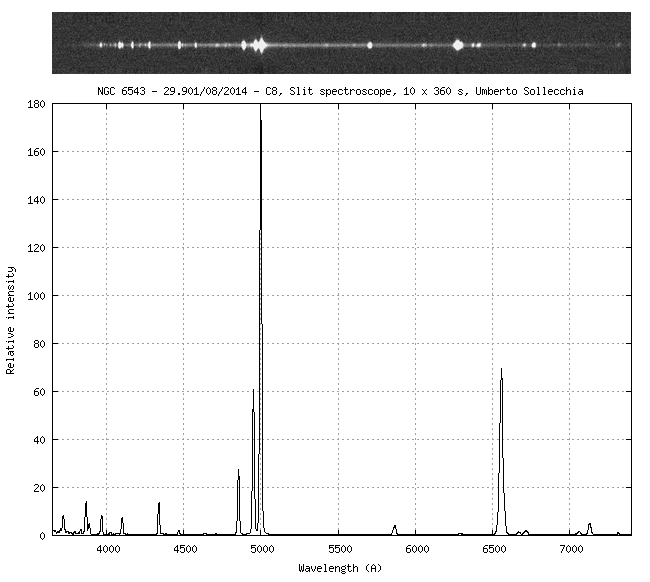150 years after... observe a planetary nebula spectrum !
Posted: Thu Aug 28, 2014 9:38 am
Hello all,
Following an idea/information from Filipe Dias, I remind you that 150 years ago (well, actually 150 years less one day!), Sir William Huggins was the first to observe a spectrum of a planetary nebula and to split apart the light coming from those stellar death shrouds:
http://www.skyandtelescope.com/astronom ... -08142014/
From that article, here are the notes from this UK observer:
On the evening of the 29th of August, 1864, I directed the telescope for the first time to a planetary nebula in Draco [NGC 6543, popularly known today as the Cat’s Eye]. The reader may now be able to picture to himself to some extent the feeling of excited suspense, mingled with a degree of awe, with which, after a few moments of hesitation, I put my eye to the spectroscope. Was I not about to look into a secret place of creation? I looked into the spectroscope. No spectrum such as I expected! A single bright line only! At first, I suspected some displacement of the prism, and that I was looking at a reflection of the illuminated slit from one of its faces. This thought was scarcely more than momentary; then the true interpretation flashed upon me. The light of the nebula was monochromatic, and so, unlike any other light I had as yet subjected to prismatic examination, could not be extended out to form a complete spectrum. . . . The riddle of the nebulae was solved. The answer, which had come to us in the light itself, read: Not an aggregation of stars, but a luminous gas.
[W. Huggins, “The New Astronomy: A Personal Retrospect,” Nineteenth Century, 41 (1897), pp. 916-17.]
Now, with all spectrographs out there, I invite you to do the same observation and capture the moment with your CCD camera or SLRs!
Publish on this forum (contact me in private if you have difficulties to register on this forum) your best planetary nebula spectra - if possible recorded on august 29th and if possible of NGC6543 nebula - to celebrate this 150th years anniversary.
Here are some references for planetary nebulae spectroscopy you may find useful:
* Low resolution spectroscopy guide from François Teyssier
http://www.astronomie-amateur.fr/index.html
* Francois presentation on planetary nebulae:
http://www.astronomie-amateur.fr/Docume ... tionPN.pdf
* Exemple of a full analysis of a planetary spectrum:
http://www.astronomie-amateur.fr/feuill ... C2392.html
* Scan of a nebula (how to make "colored" 2D images of nebulae from spectral scans):
http://www.astrosurf.com/buil/scan/demo.htm
Cordialement,
Olivier Thizy
Vous ne verrez plus des étoiles comme avant !
http://www.shelyak.com/en/
Following an idea/information from Filipe Dias, I remind you that 150 years ago (well, actually 150 years less one day!), Sir William Huggins was the first to observe a spectrum of a planetary nebula and to split apart the light coming from those stellar death shrouds:
http://www.skyandtelescope.com/astronom ... -08142014/
From that article, here are the notes from this UK observer:
On the evening of the 29th of August, 1864, I directed the telescope for the first time to a planetary nebula in Draco [NGC 6543, popularly known today as the Cat’s Eye]. The reader may now be able to picture to himself to some extent the feeling of excited suspense, mingled with a degree of awe, with which, after a few moments of hesitation, I put my eye to the spectroscope. Was I not about to look into a secret place of creation? I looked into the spectroscope. No spectrum such as I expected! A single bright line only! At first, I suspected some displacement of the prism, and that I was looking at a reflection of the illuminated slit from one of its faces. This thought was scarcely more than momentary; then the true interpretation flashed upon me. The light of the nebula was monochromatic, and so, unlike any other light I had as yet subjected to prismatic examination, could not be extended out to form a complete spectrum. . . . The riddle of the nebulae was solved. The answer, which had come to us in the light itself, read: Not an aggregation of stars, but a luminous gas.
[W. Huggins, “The New Astronomy: A Personal Retrospect,” Nineteenth Century, 41 (1897), pp. 916-17.]
Now, with all spectrographs out there, I invite you to do the same observation and capture the moment with your CCD camera or SLRs!
Publish on this forum (contact me in private if you have difficulties to register on this forum) your best planetary nebula spectra - if possible recorded on august 29th and if possible of NGC6543 nebula - to celebrate this 150th years anniversary.
Here are some references for planetary nebulae spectroscopy you may find useful:
* Low resolution spectroscopy guide from François Teyssier
http://www.astronomie-amateur.fr/index.html
* Francois presentation on planetary nebulae:
http://www.astronomie-amateur.fr/Docume ... tionPN.pdf
* Exemple of a full analysis of a planetary spectrum:
http://www.astronomie-amateur.fr/feuill ... C2392.html
* Scan of a nebula (how to make "colored" 2D images of nebulae from spectral scans):
http://www.astrosurf.com/buil/scan/demo.htm
Cordialement,
Olivier Thizy
Vous ne verrez plus des étoiles comme avant !
http://www.shelyak.com/en/
